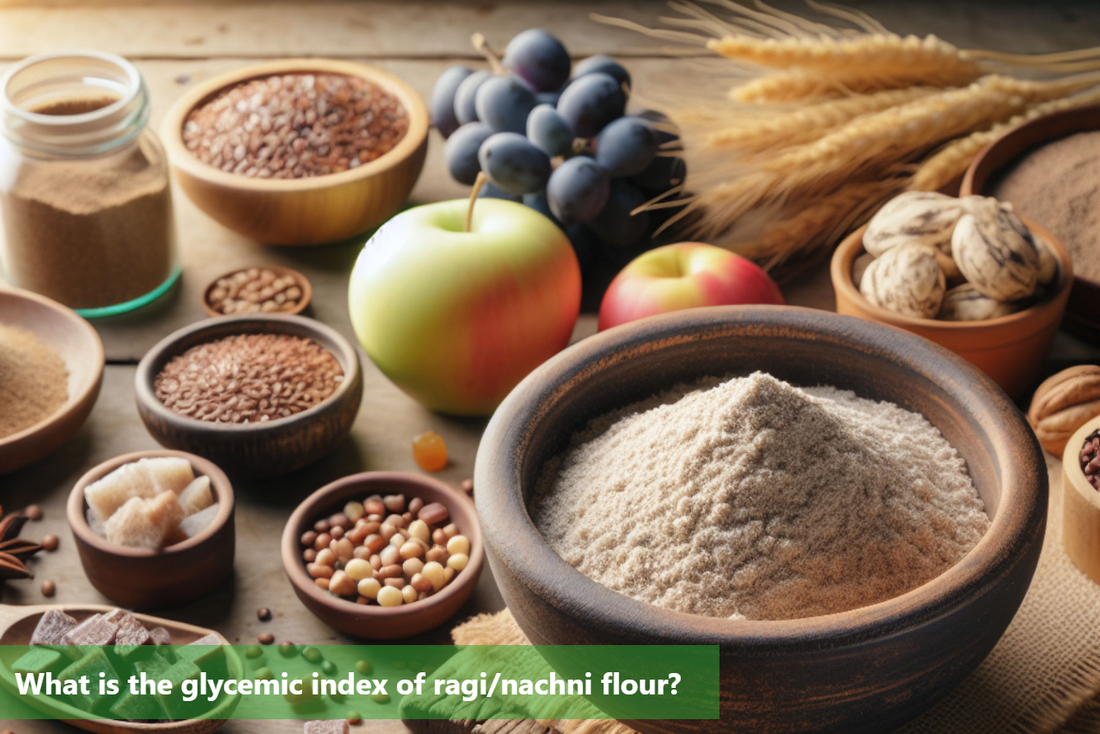Ragi, also called Nachni, has been a main food in South India for many years. It comes from the finger millet and is free from gluten. This flour is becoming more popular because it is very healthy and can help with diabetes. Ragi flour has lots of important amino acids, vitamins, and minerals. People like it because it has a lot of protein and fiber.
Ragi is good for people with diabetes because it is digested slowly and does not cause a quick rise in blood sugar. When we learn about the history and health benefits of ragi flour, we find out that it is a good option for people with diabetes instead of regular flour.
Understanding Glycemic Index
The glycemic index (GI) ranks carbohydrates based on their impact on blood glucose levels. This index is crucial for individuals with diabetes as it helps understand how different foods affect blood sugar. The GI scale ranges from 0 to 100 with low GI foods digested slower, causing a gradual rise in blood glucose levels, while high GI foods are rapidly digested, leading to quick spikes in blood glucose. Understanding the GI helps make informed dietary choices to manage blood sugar levels effectively. Low GI foods maintain stable blood glucose levels, while high GI foods may cause rapid fluctuations. By paying attention to the GI, individuals with diabetes can better control their blood sugar levels and reduce the risk of complications.
The glycemic index (GI) of ragi flour, also known as finger millet flour, is generally considered low to moderate. Here's an approximate range:
Glycemic Index: Around 65 (moderate)
Ragi flour is often recommended for its relatively lower GI compared to refined grains like wheat flour. This means it raises blood sugar levels more slowly and steadily, which can help in managing blood glucose levels effectively, especially for individuals with diabetes. Including ragi flour in meals can contribute to better glycemic control and provide other nutritional benefits due to its higher fiber and nutrient content compared to refined grains.
Glycemic Index of Ragi/Nachni Flour
The Nutritional value of ragi is as per 100g serving:
Energy |
336 kcal |
Protein |
7.7 gm |
Fat |
1.5 gm |
Fibre |
11.5 gm |
Carbohydrate |
72.6 gm |
Calcium |
350 mg |
Iron |
3.9 mg |
Magnesium |
137 mg |
Phosphorus |
283 mg |
Manganese |
5.94 mg |
Potassium |
408 mg |
Health Benefits of Ragi Flour for Diabetes
Ragi flour, also known as finger millet flour, is known for its numerous health benefits, particularly in managing diabetes. Here are some of the health benefits of including ragi flour in a diabetic diet:
Low Glycemic Index: Ragi flour has a low glycemic index, which means it helps in controlling blood sugar levels. This is especially beneficial for individuals with diabetes as it prevents sudden spikes in blood sugar levels.
Rich in Dietary Fiber: Ragi flour is high in dietary fiber, which aids in better management of diabetes by controlling blood sugar levels and improving digestion.
Packed with Nutrients: It is a good source of essential nutrients such as calcium, iron, and vitamin D, which are beneficial for overall health, especially for individuals with diabetes.
Gluten-Free: Ragi flour is naturally gluten-free, making it an ideal choice for those with diabetes who also have gluten sensitivity or celiac disease.
Weight Management: Consumption of ragi flour can help in maintaining a healthy weight, which is essential for managing diabetes effectively.
Incorporating ragi flour into a diabetic diet can provide a range of health benefits and contribute to better blood sugar control.
Ragi Flour for Managing Diabetes
In short, ragi flour is a great option for managing diabetes because it has a low glycemic index (GI) and lots of fiber. Unlike other grains and flours, ragi flour doesn't cause a quick spike in blood sugar levels after you eat it. This slow release of sugar helps to control blood sugar levels, which is good for people with diabetes. Also, the fiber in ragi flour helps to regulate blood sugar levels and keeps your digestion healthy.
To sum up, ragi flour's low glycemic index and nutritional content make it a good choice for people trying to manage diabetes and control their blood sugar levels. It's a valuable addition to the diet of anyone looking to eat foods that are good for diabetes or have a low glycemic index.
Best Ways to Incorporate Ragi into Your Diet for Diabetes Management
Ragi, also known as finger millet, is a highly nutritious grain with several health benefits, especially for individuals with diabetes. It is rich in fiber, which can help regulate blood sugar levels and improve insulin response. Here are some of the best ways to incorporate ragi into your diet for effective diabetes management:
Ragi Porridge: Start your day with a warm and comforting bowl of ragi porridge. Mix ragi flour with water or milk and cook it until it reaches a thick, creamy consistency. You can sweeten it with a natural sweetener like stevia or add some chopped fruits for extra flavor.
Ragi Roti: Prepare soft and nutritious ragi rotis by combining ragi flour with water and a pinch of salt. Knead the dough and flatten it into thin circles. Cook the rotis on a hot skillet until they turn golden brown. Enjoy them with your favorite vegetable curry or yogurt.
Ragi Idli or Dosa: Incorporate ragi into your breakfast routine by making ragi idlis or dosas. Combine ragi flour with urad dal and ferment the batter overnight. Steam the batter in idli molds or spread it thinly on a hot griddle to make crispy dosas.
Ragi Cookies or Biscuits: Indulge in healthy snacking by baking ragi cookies or biscuits. Mix ragi flour with a small amount of sugar, ghee, and a pinch of baking powder. Shape the dough into small cookies and bake them until they are crispy and golden.
Ragi Upma: Make a nutritious and savory ragi upma by sautéing ragi flour with vegetables, spices, and water. Garnish with fresh cilantro and serve hot for a satisfying and wholesome meal.
Incorporating ragi into your diet can be a delicious and beneficial way to manage diabetes. However, it is important to consult with a healthcare professional or a dietitian to create a personalized meal plan that suits your specific dietary needs and health goals.
This Blog post is an initiative by DiabeSmart, to provide accurate and Nutritionist / Doctor approved information related to Diabetes. DiabeSmart is India's first Food brand designed specifically for Diabetics, that has been clinically tested on Diabetics and Pre-Diabetics to deliver 55% - 70% lower Sugar spikes. DiabeSmart is part of Lo! Foods - India's leading brand for Everyday Functional Health foods.












